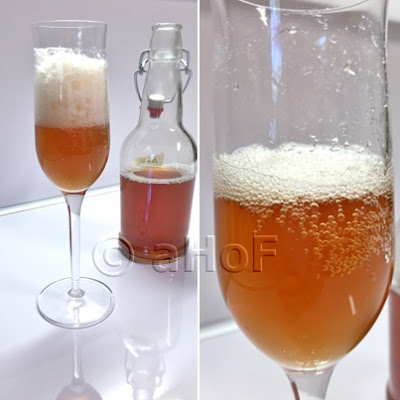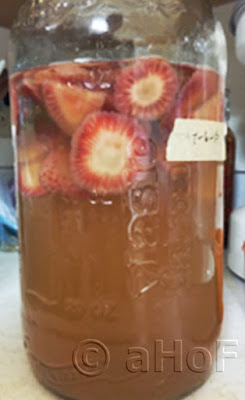 |
| Pomegranate Flavored Kombucha |
I was so excited last week, the day my SCOBY was to arrive - that I completely forgot to take any photos of it when it came! The temperature of SCOBY and the tea must be the same, so it took some time and monitoring to have them become equal. And then I slipped the SCOBY into the tea - set it on top of the fridge, covered and thought - DRAT! forgot to photograph.
I had planned to get photos yesterday when draining and making the new batch of tea - and again I forgot. That said, the kombucha was delicious! I am hoping the pomegranate juice (from a jar) will also be as good as I anticipate.
 |
| Plain Kombucha in front and Pomegranate Kombucha behind |
As I saw no new baby SCOBY, I looked online for that concept and found that yes, if the SCOBY is weak, it may not produce a new SCOBY the first and even possibly a second time, but eventually, given its preferred diet of sweet tea, it will recover. I hope next week to see a new baby SCOBY on top. Meanwhile, there was nothing wrong with the one I got, because the tea was fermented nicely and the flavor was very similar to the store bought bottle (only better!).
I used one gallon of boiled water, 2 tablespoons of black tea, steeped for 10 minutes, then sweetened with 1 cup of cane sugar. Actually, since it is taking such a very long time to cool the tea, this time I steeped the 2 tablespoons of tea in one quart of boiling water, then sweetened it and added in the other 3 quarts of water. This way it only took 5 hours for the tea to cool to the 77 degrees of the SCOBY!
I am using the continuous brew method. I bought a large 1½ gallon glass jar with spigot. I drained off the tea, leaving about 2 cups in the bottom of the jar, and added the new batch of tea on top.
It remains to see the flavor of the pomegranate kombucha, but it surely looks pretty. The plain is delicious. This is fast becoming a love affair!
July 30, 2015: Three days later . . .
 |
| Just Poured, left | after 20 seconds, right |
My passion is teaching people how to create a harmony of flavors with their cooking, and passing along my love and joy of food, both simple or exotic, plain or fancy. I continue my journey in ethnic and domestic cuisines, continuing my journey to explore diverse culinary experiences and hopefully to start you on a journey of your own. Join me also at A Harmony of Flavors on Facebook, and Pinterest.

























